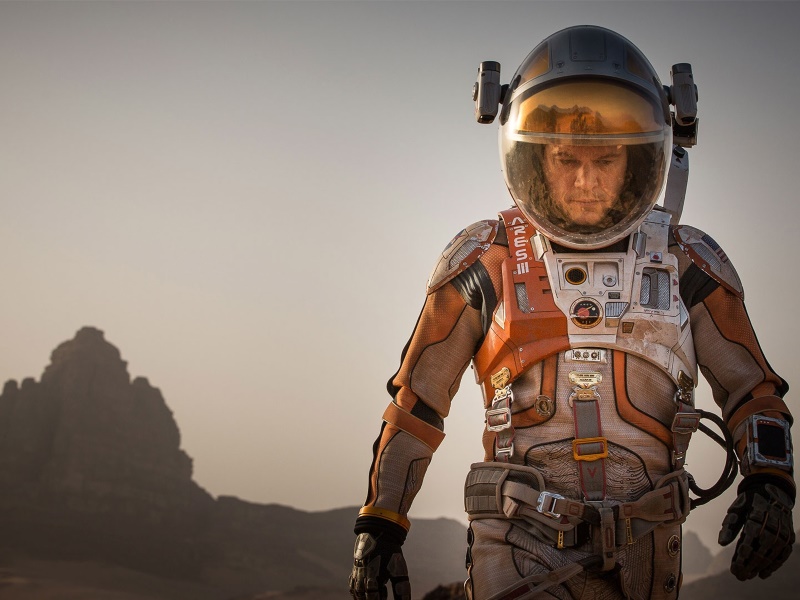- Home
- Science
- Science Features
- Nasa and the Author of 'The Martian' Tell Us Exactly How We'll Get to Mars
Nasa and the Author of 'The Martian' Tell Us Exactly How We'll Get to Mars

But Earth's first manned mission to Mars will share little resemblance to the hit film - not to mention the book it's based on, according to author Andy Weir and top Nasa officials.
Despite winning plaudits for making "The Martian" as scientifically accurate as possible, Weir thinks the real thing is likely to involve a smaller role for Nasa and a bigger role for robots, 3D printing and private spaceflight companies.
"It won't look anything like it looked in the movie," he said at "Transformers," an event hosted by The Washington Post Wednesday.
It might surprise you to hear that Nasa completely agrees.
"Andy . . . he's absolutely right," said Nasa Administrator Charles Bolden. "If you look at what Nasa's doing today, a big part of my life is spent growing international partners, looking out for what we call non-traditional partners, countries that want to be a part of the space program."
An actual human mission to Mars, according to Bolden and Weir, will involve a lot more of these actors. It won't be just Nasa sending a team to the red planet; instead, it'll likely be a multi-national coalition of governments and corporations. By the time we're ready for a manned mission, this group will already have set up some infrastructure in low-earth orbit designed to support interplanetary travel.
Because it's costly and difficult to fit enough supplies for a mission onto a single spaceship launched from Earth itself, it'll be a lot easier and cheaper if we can assemble all the necessary equipment from a staging point in space, perhaps in low orbit around the Earth, before firing the whole package off to Mars. This is where private companies like SpaceX come into play.
"If I were king of Nasa," said Weir, "if I could just make edicts and have things go the way I wanted, I would concentrate on commercial space side - get as much of my money into the commercial side as possible, because they will very quickly drive down the price to [low-earth orbit], and that makes the cislunar- and Mars-related missions affordable."
Right now, it costs tens of thousands of dollars to put even a single kilogram of cargo into space. But if competition for commercial space launches can drive costs down to the level of conventional air shipping, that figure might drop to less than $50 per kilogram, said Weir.
Here's another major way our first manned Mars missions will differ from Weir's book. Instead of landing directly on the planet, astronauts will probably begin by orbiting Mars' moons, Phobos and Deimos. From there, the people will be able to control a bunch of rovers in real time - which would be a huge change. Currently, the distance between Earth and Mars means it's only possible to control rovers with a time delay; it takes hours to transmit instructions to our Martian landers, even though those signals travel at light speed.
That said, Nasa does ultimately plan to send people to Mars itself. The agency is already busy scoping out possible landing sites, said Bolden, with the key criterion for each one being the likelihood of finding water there.
And when that happens, there is one aspect of "The Martian" that will probably play out in real life just as it did in fiction. It turns out that dropping supplies on the planet long before the humans ever get there does make a lot of economic sense. Advanced robots - some might be humanoid, Bolden speculates - could 3D print and assemble the habitats and other equipment that people would need on Mars. From surveying the planet ahead of time to preparing the local environment for human visitors, these "precursor" missions will be crucial for the future of Mars exploration, according to Bolden.
"We've been on Mars for 40 years," he said. "We didn't just come to this rodeo."
© 2016 The Washington Post
For the latest tech news and reviews, follow Gadgets 360 on X, Facebook, WhatsApp, Threads and Google News. For the latest videos on gadgets and tech, subscribe to our YouTube channel. If you want to know everything about top influencers, follow our in-house Who'sThat360 on Instagram and YouTube.
Related Stories
- Samsung Galaxy Unpacked 2025
- ChatGPT
- Redmi Note 14 Pro+
- iPhone 16
- Apple Vision Pro
- Oneplus 12
- OnePlus Nord CE 3 Lite 5G
- iPhone 13
- Xiaomi 14 Pro
- Oppo Find N3
- Tecno Spark Go (2023)
- Realme V30
- Best Phones Under 25000
- Samsung Galaxy S24 Series
- Cryptocurrency
- iQoo 12
- Samsung Galaxy S24 Ultra
- Giottus
- Samsung Galaxy Z Flip 5
- Apple 'Scary Fast'
- Housefull 5
- GoPro Hero 12 Black Review
- Invincible Season 2
- JioGlass
- HD Ready TV
- Laptop Under 50000
- Smartwatch Under 10000
- Latest Mobile Phones
- Compare Phones
- Moto G15 Power
- Moto G15
- Realme 14x 5G
- Poco M7 Pro 5G
- Poco C75 5G
- Vivo Y300 (China)
- HMD Arc
- Lava Blaze Duo 5G
- Asus Zenbook S 14
- MacBook Pro 16-inch (M4 Max, 2024)
- Honor Pad V9
- Tecno Megapad 11
- Redmi Watch 5
- Huawei Watch Ultimate Design
- Sony 65 Inches Ultra HD (4K) LED Smart TV (KD-65X74L)
- TCL 55 Inches Ultra HD (4K) LED Smart TV (55C61B)
- Sony PlayStation 5 Pro
- Sony PlayStation 5 Slim Digital Edition
- Blue Star 1.5 Ton 3 Star Inverter Split AC (IC318DNUHC)
- Blue Star 1.5 Ton 3 Star Inverter Split AC (IA318VKU)

















